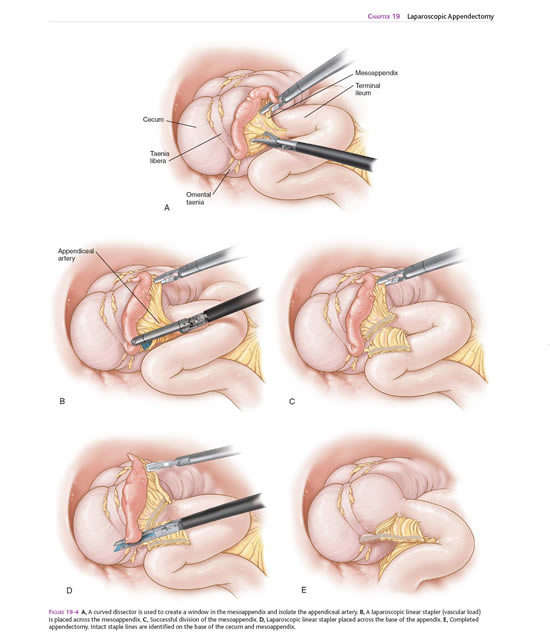Laparoscopic Appendectomy (surgical removal of the appendix)
A. The Condition. The appendix is a small pouch that hangs from the large intestine where the small and large intestine join. Appendectomy is the surgical removal of the appendix. The operation is done to remove an infected appendix. An infected appendix, called appendicitis, can burst and release stool and bacteria into the abdomen.
B. Symptoms
- Abdominal pain that starts around the navel
- Not wanting to eat
- Low fever
- Nausea and sometimes vomiting
- Diarrhea or constipation
C. Laparoscopic Appendectomy. The surgeon will make about 3 small incisions in the abdomen. A port (nozzle) is inserted into one of the slits, and carbon dioxide gas inflates the abdomen. This process allows the surgeon to see the appendix more easily. A laparoscope is inserted through another port. The laparoscope looks like a telescope with a light and camera on the end so the surgeon can see inside the abdomen. Surgical instruments are placed in the other small openings and used to remove the appendix. This is done with a surgical stapler. The diseased appendix then is placed into a plastic bag, and removed from the abdomen through one of the small incisions. After the appendix has been removed, the carbon dioxide is released out of the abdomen through the slits, and then these sites are closed with sutures or staples, or covered with glue-like bandage and steri-strips.
D. Nonsurgical Treatment. If you only have mild signs of appendicitis, your surgeon may monitor you to see if the symptoms get any worse. If you have an abscess (a collection of pus), your surgeon may treat you with antibiotics first and have you come back for elective surgery in 4 to 6 weeks. In some cases of abscess, a small (pencil-thin) tube may be inserted into the abscess by a radiologist to allow for the drainage of pus. Such a tube may remain in place for several weeks.
E. Risks. The primary risks of appendectomy are:
- Infection of the skin at one of the small ports sites
- Collection of pus inside your abdomen (intraabdominal abscess)
- Postoperative ileus (the intestines slow down/stop working for several days)
- Leakage from the stump of the appendix
F. Expectations
1. Before Your Operation. Appendectomy usually is an emergency procedure, so there will be little time for you to prepare. Evaluation usually includes blood work, urinalysis, and an abdominal CT scan or abdominal ultrasound. Your surgeon and anesthesia provider will review your health history, medications, and options for pain control.
2. Your Recovery. You usually can go home in 1 or 2 days after a laparoscopic procedure. You will be given medication for pain, and you may be given antibiotic pills. You should limit your activity to light lifting (no more than 15 lb) for one month.
3. Call Your Surgeon. If you are in severe pain, have stomach cramping, a high fever, odor or increased drainage from your incision, or no bowel movements for 3 days, then call your surgeon.
G. Pertinent References.
Zografakis JG. Laparoscopic Appendectomy. In: Frantzides CT, Carlson MA, eds. Atlas of Minimally Invasive Surgery. Philadelphia: Saunders Elsevier, 2009.
Ludwig K.A., and Frantzides, C.T.: Laparoscopic appendectomy – In Laparoscopic and Thoracoscopic Surgery. Ed Frantzides, Mosby-Yearbook Inc., 1994.

